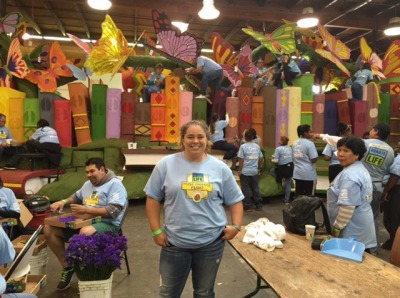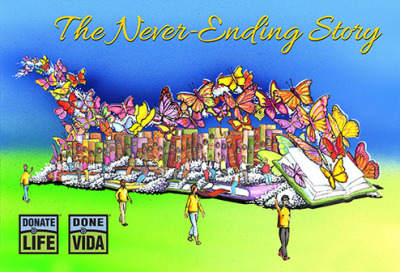County Family Contributes to Floral Fantasy Representing a Final Gift
/ Amanda Patmon, second from right, and Theresa Liget, on the far right, work on cutting flowers for the float.When you wake up to watch the Pasadena Tournament of Roses Parade on New Year’s Day, be on the lookout for a float with a special County touch.
Amanda Patmon, second from right, and Theresa Liget, on the far right, work on cutting flowers for the float.When you wake up to watch the Pasadena Tournament of Roses Parade on New Year’s Day, be on the lookout for a float with a special County touch.
Theresa Liget, who works in the Medical Examiner’s Office, and her daughter Amanda Patmon, who works at the San Diego County Sheriff’s Academy, were up bright and early Saturday, Dec. 6 to board a bus headed to the Rosemont Pavilion warehouse to work on Donate Life’s float in the parade. This will be the fifth float they have worked on together for Donate Life.
Donate Life is the parent company of Lifesharing, the region’s tissue and organ donation organization. The Medical Examiner’s Office works closely with Lifesharing, as well as the San Diego Eye Bank, to provide hundreds of tissue and organ donations per year.
This year’s float is called “The Never-Ending Story” and features 60 butterflies emerging from books. The butterflies represent all the lives that can be transformed from a single donor. The float also features special images of donors called floragraphs. They’re given that name because all floats in the parade are covered in flowers and other plant materials.

“Our tiny contribution to the float has so much meaning to us. The real story is the people we have met each year and their stories,” says Liget. “We have met donor families who are in Pasadena preparing floragraph portraits of their deceased loved one to be displayed on the float. We have met recipients who are there because of the sacrifice of a donor.”
Patmon says she was especially touched when she met the family of San Diego Police Officer Jeremy Henwood, who was honored with a floragraph on a float last year. His organs transformed at least two lives.
Float volunteer workers get to know each other on the bus ride up to Pasadena, then more so while working and on the ride back home. In all, they work about eight hours.
“It’s so much fun. It’s a really, really cool experience,” says Patmon.
So, what does it take to decorate an elaborate Rose Parade float? Most floats are built by professional float-building companies and are kept in an enormous warehouse. By the time volunteers arrive, the float is constructed and is spray colored to match the flowers that will be attached to each area. Patmon says the volunteers are given an empty box to fill with specific-colored flowers that must be cut precisely.
“We sat for hours cutting only the blue part from the Blue Strata flower, “says Liget. “Only the flower, to capture all the blue – to cut down too far and add green to the pile would diminish the color that will be added to the float.”
Patmon adds, “Your hands hurt from cutting with the scissors and your back hurts a little from sitting in the chair, but it doesn’t even matter because you’re able to walk around and see everything that’s going on. I always find out where on the float my flowers are going. Everyone that day was working on the butterfly on the front of the float, it’s a huge butterfly.”

Paid workers and more busloads of volunteers will continue to work on the float until it is done. Fresh and dried flowers are applied to the float two to three days before the parade.
Liget says she hopes people who watch the parade on January 1 will not only admire the beauty of the Donate Life float but will also and listen to the stories of the individuals who have given so much in death to enhance the lives of the living.
“Every donation of organs, eyes and tissue begins when a family member honors their loved ones’ wishes indicated by a pink dot on their driver’s license, or by making that decision for them,” says Liget.
